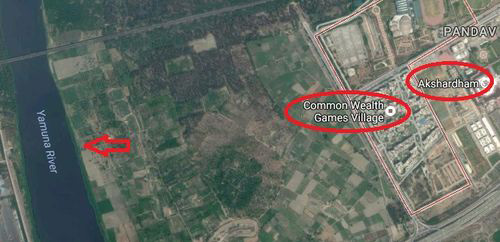The Yamuna river, once a part of the legacy of Delhi, now symbolises the city's own sorrow. Messing up with the Yamuna and its sensitive floodplain is not a new story. With land regulations along the river going for a toss, not only has the majestic river constricted, but its floodplains have narrowed drastically. Massive structures like the Commonwealth Games Village, the Akshardham Temple and the Millennium bus depot have encroached on this ecologically fragile area, killing the rich living resource one step at a time. And now, spiritual guru Sri Sri Ravi Shankar's Art of Living foundation has hammered another nail in the coffin.
The World Culture Festival organised by Art of Living has 'completely destroyed' the entire Yamuna floodplain, an expert committee has told the National Green Tribunal (NGT). The venue of the festival, organised to celebrate 35 years of the Art of Living foundation, was sprawled across 1,000 acres of the Yamuna floodplain in Delhi.
The event, billed as the biggest ever festival of music and dance, had drawn sharp criticism from environmentalists and continues to be a sensitive topic because of the 'irreparable' damage to the floodplain.
What is a floodplain?
Floodplain is the low-lying area adjacent to a river that is prone to flooding. Floodplains support biologically diverse ecological communities, a range of threatened species and provide food for aquatic animals such as fish and water birds. These ecologically sensitive areas require conservation. There is another reason why you should be conserving floodplains—rain water travels deep into the ground of a floodplain, replenishing ground water supply.
What Yamuna floodplain means for Delhi?
 Google Earth image showing Yamuna river, the Commonwealth Games Village and Akshardham Temple
Google Earth image showing Yamuna river, the Commonwealth Games Village and Akshardham Temple
Under the city master plan, the river zone area—called zone O—was identified as 9,700 hectares, of which 1,600 ha is under water and the rest is considered to be mostly dry. Over the years, however, a number of planned and unplanned developments have been undertaken in this zone. Scientists and environmentalists, however, have stressed the importance of conserving the floodplains as a water reservoir for the capital.
Scarcity of groundwater is a serious issue in the capital. The most valuable groundwater recharge zone is the Yamuna floodplain. However, it has been extensively used for urbanisation and thus squeezed up leaving a paltrier area for recharging groundwater reservoirs, according to a report Constriction of the Yamuna river floodplains within Delhi region: a serious concern. A 50-km stretch can supply 250 million cubic metres of water every year, which can meet the needs of 1.3 million people, experts say. A city like Delhi, which struggles with water shortage, should not have messed with this potential water resource.
How did the event affect the floodplain?
Massive preparations went in for the 'Kumbh Mela of culture'—vegetation was cut, dirt tracks were laid, tents put up and pontoon bridges built. Over 37,000 artistes and 8,500 musicians from all over the world performed on a seven-acre stage, said to be the largest in the world. The entire area was flattened. After activists led by Manoj Mishra of the Yamuna Jiye Abhiyan filed a petition, the National Green Tribunal slapped a fine of Rs 5 crore on the organisers, calling the event an ecological disaster. Irreparable damage has been caused to the floodplains, say environmentalists. The report says there has been an ‘invisible loss of biodiversity which cannot be easily assessed, and most may never be able to return.'
In the process of dumping mud and flattening to set up the venue, the surface has been hardened. This will severely impact the groundwater recharge ability. In a hard-hitting report, the expert committee appointed by the NGT to assess the damage to the floodplain, said: “The ground is now totally levelled, compacted and hardened and is totally devoid of water bodies or depressions and almost completely devoid of any vegetation.”
The AOL is also said to have introduced enzymes into the Yamuna water to get rid of the unbearable stench of polluted water before they could host the mega event, which saw leaders from a host of countries as guests. In a post on their official website, the AOL clarifies that the enzyme is purely organic. The enzyme was produced from organic kitchen waste by 1,00,000 volunteers over a period of three months.







